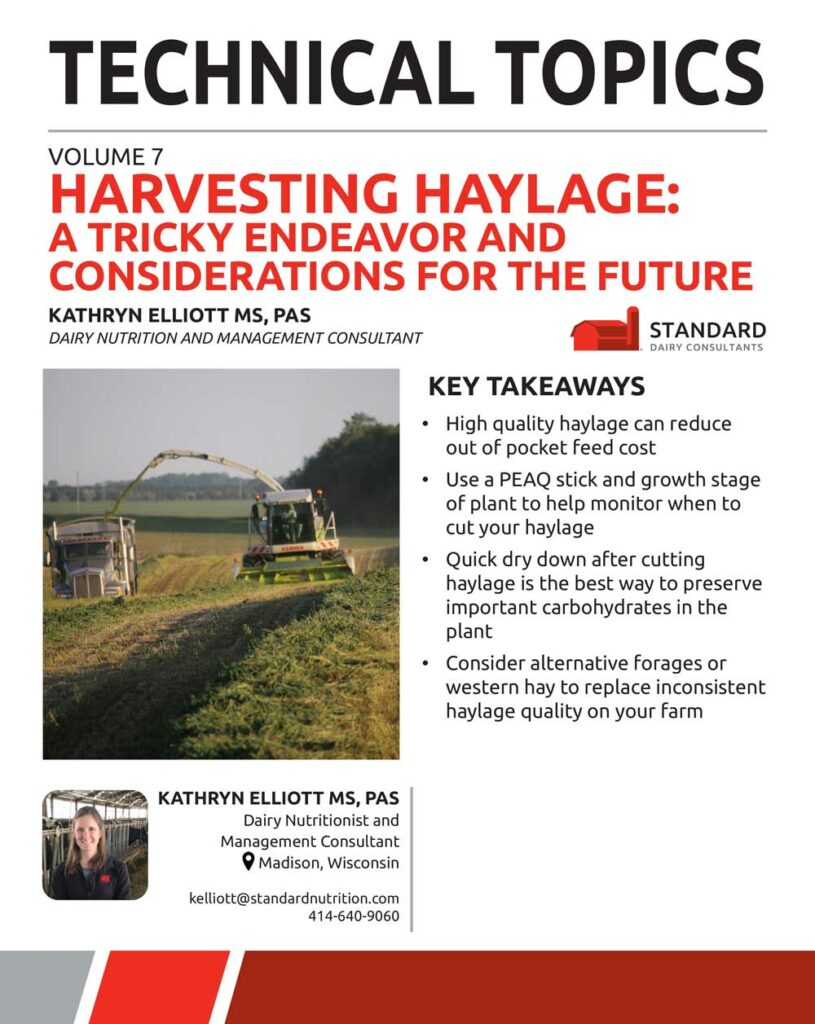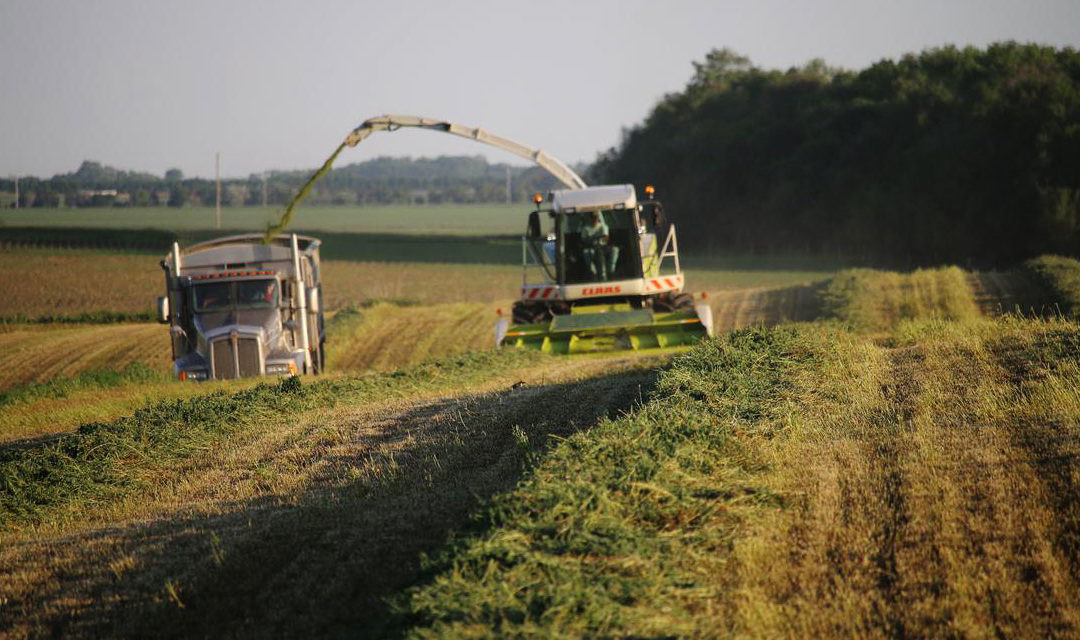Written by: Kathryn Elliott, MS, PAS
KEY TAKEAWAYS IN THIS ISSUE OF TECHNICAL TOPICS:
- High-quality haylage can reduce out-of-pocket feed cost
- Use a PEAQ stick and the growth stage of the plant to help monitor when to cut your haylage
- Quick dry down after cutting haylage is the best way to preserve important carbohydrates in the plant
- Consider alternative forages or western hay to replace inconsistent haylage quality on your farm

WHY IS QUALITY HAYLAGE IMPORTANT?
Winter is finally loosening its grip and sunny, warm weather is approaching quickly. Many dairy producers should start to think about how they will harvest quality haylage for the year. The last few winter seasons followed by wet springs have made it difficult to harvest high-quality haylage and keep up with haylage inventory, making haylage a high-priced forage. Since haylage is expensive and you need it for milk production, it is important to harvest haylage high in protein, sugars, and digestibility.
High-quality haylage allows you to remove some out-of-pocket feed expenses from your ration. For example, we can compare haylage quality by using the relative feed quality (RFQ) and the amount of crude protein (CP) of the haylage. If a dairy producer had haylage at 21% CP with low RFQ at 135, they would have to feed approximately an extra pound of soybean meal in order to achieve the same amount of milk as a producer that had a higher quality haylage at 22% CP and 180 RFQ, according to ration balancing with Cornell Net Carbohydrate and Protein System (CNCPS). The producer with the lower quality haylage would have a higher out-of-pocket feed cost of about 16 cents per cow per day to feed the extra soybean meal. This cost can add up very quickly and so it makes a huge difference if you can improve the protein content and RFQ of your haylage!
Keep in mind that harvesting high-quality haylage yields fewer tons per acre as you need to harvest the plant when it is younger and not as tall. Producers need to consider what their haylage needs are for dairy as a whole. If they need inventory to feed dry cows and heifers, then that can be a lower quality haylage that yields more per acre as those animals are not producing milk and won’t need as much commodity supplementation to meet their nutritional needs. In addition, the yield on each haylage crop, i.e. first cutting, second cutting, etc., will vary so the dairy producer should think about which crop will feed which group of animals. Generally, first-cutting hay has the lowest protein due to growth in the wet spring weather and can be used to feed dry cows and heifers. It can also be a good base for a milk cow ration to balance out the higher digestible subsequent hay cuttings.
WHEN SHOULD YOU HARVEST HAYLAGE AND WHAT SHOULD YOU DO?
Once you know what your haylage needs are, then you can determine the timing of harvest for each crop of haylage. The general rule of thumb for haylage is to harvest every 28 days after the first cutting. As we’ve experienced the last couple of years, it can be hard to harvest every 28 days due to inconsistent weather patterns. I would use the 28-day interval as an estimate of when the next cutting might be and in addition, go out and scout the field and cut based on plant growth stage and maturity. See the image on the left for plant growth stages. You will get the highest quality forage by cutting before flowering at the bud and vegetative state. The plant’s growth stage and maturity can change quickly due to the weather. If it’s hot and sunny the plant will mature quickly and maybe not grow as tall. If wet and cool the plant will mature and grow slower. Producers can use a PEAQ stick (Predictive Equation for Alfalfa Quality) or height and stage of growth to determine the forage quality. The table to the right includes using the relative feed value (RFV) of the forage determined by its height and stage of growth. Keep in mind that the forage usually loses 20 points of RFV from the time of harvest to placing in storage. This means if you are aiming for an RFV of 150 you should cut the alfalfa when it is predicted to be 170 RFV standing.
Not only is it important to know when to cut for quality, but also when to cut for the higher carbohydrate content and a quick dry down. Sugars are the main source of carbohydrates in alfalfa. Research has confirmed that alfalfa has higher carbohydrate content in the afternoon because carbohydrates accumulate during daylight hours and are produced faster than the plant can translocate them to the root or crown. Concentrations of carbohydrates reach a peak in the late afternoon.
Once the plant is cut, it continues respiration and uses up the carbohydrates until the moisture in the plant reaches 50%. In western, arid regions late afternoon cutting can work as low humidity and sunshine will dry the plant down quickly and preserve carbohydrate content. In the high humidity of the Midwest, it is usually not possible to cut the plant in the late afternoon and get a quick enough dry down. In order to best preserve carbohydrate content in the Midwest, cut in the morning on a sunny day and get rapid dry down of the plant during daylight hours. To get the most effective rapid dry down you will want to have a wide swath. You should have a swath that covers at least 60% of the cut area for the best dry-down.
WHAT CAN YOU CONSIDER FOR THE FUTURE IF YOU HAVE LOW OR INCONSISTENT HAYLAGE INVENTORY?
Due to the inconsistencies and frustrations of harvesting haylage and having weather such a high influencer of the quality, you could consider moving away from haylage to bring in a more consistent forage. Buying dry hay from western states is reliably consistent in quality and can replace inconsistent haylage yield and quality. In addition, some may consider planting BMR forage sorghum to feed a ration that is high in corn silage and low in the hay. The BMR characteristic will bring the quality of highly digestible fiber and work to maintain the number of fermentable starches in the total ration at a safe enough level to prevent rumen acidosis or hemorrhagic bowel syndrome. If you choose to feed dry western hay, make sure it gets cut to 2-3 inches when feeding it in a total mixed ration. This prevents the cows from sorting the ration.
In summary, there is a lot to think about in planning for your future forage inventory. High quality haylage is probably still the best out-of-pocket money saver since you can feed fewer commodities to make the same amount of milk. The quick dry down of haylage after it is cut is the best way to preserve the nutritional content. It’s always good to think about what options are available for future milking rations should you run low on haylage inventory and quality. Consult your nutritionist on exploring the best options for your dairy situation.
LOW-LIGNIN ALFALFA
To help create high-quality haylage, products like low-lignin alfalfa (also phrased as reduced-lignin alfalfa) can be used. Low-lignin alfalfa reduces lignin content in the plant by 7 to 18% depending on the product planted (i.e. HarvXtra or Hi-Gest 360). Lignin makes up an indigestible, fibrous portion of the plant, providing the strength necessary to stand upright. The more lignin in the plant, the less digestible it is. There are multiple advantages to using low-lignin alfalfa. One is that you can continue to harvest as you normally would and achieve a higher digestible crop. Another is that you can extend your harvest window. Extending the harvest window allows you to achieve a quality crop even if the weather should slow you down. A longer harvest window can also extend the stand life of your alfalfa by reducing the number of cuts you take per year. Since weather is so unpredictable, your greatest advantage to low-lignin alfalfa is extending your harvest window so that you can still acquire quality alfalfa even though it may have been in the field longer than you would’ve liked. You can view this as a kind of insurance policy on your haylage quality and it may save you during years the weather is bad!


